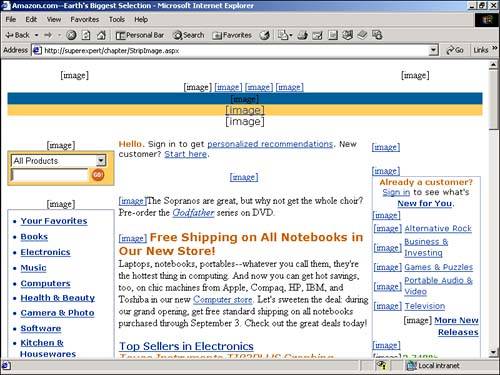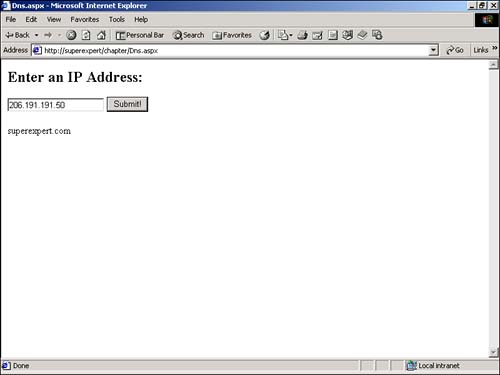Accessing Other Web Sites with HTTP
| The .NET Framework contains a rich set of classes for accessing other Web sites across the Internet. You can use these classes to perform such actions as retrieving Web pages from other Web sites, posting form data to other Web sites, and resolving DNS host names and IP addresses. Why would you want to do this? One common problem that Web sites face is how to share information across the Internet. Suppose, for example, that you are a book distributor and you want to automatically send a list of top-selling books to all your affiliate Web sites. In this situation, you could create a Web page on the main distribution Web site with a list of top-selling books. Your affiliate Web sites could then use the .NET classes described in this section to automatically retrieve this Web page and display the list of top-selling books. NOTE A better alternative for distributing information across the Internet is XML Web Services. XML Web Services are described in detail in Part VI of this book, "Building ASP.NET Web Services." The .NET classes for Internet access can be roughly divided into three groups:
All the Internet access classes can be found in the System.Net and System.Net.Sockets namespaces. Using the WebClient ClassThe easiest way to grab a page off another Web server is to use the WebClient class. The WebClient class has three methods for downloading data:
For example, the page in Listing 26.18 retrieves the home page from the Amazon.com Web site, replaces any image tags with the string [image] , and displays the altered page (see Figure 26.6). Listing 26.18 StripImage.aspx<%@ Import Namespace="System.Net" %> <Script Runat="Server"> Sub Page_Load Dim wcMicrosoft As WebClient Dim objUTF8Encoding As UTF8Encoding Dim strResponse As String wcMicrosoft = New WebClient objUTF8Encoding = New UTF8Encoding strResponse = objUTF8Encoding.GetString( _ wcMicrosoft.DownloadData( "http://www.amazon.com" ) ) strResponse = RegEx.Replace( strResponse, "(<img.*?>)", "[image]", RegExOptions.SingleLine ) Response.Write( strResponse ) End Sub </Script> The C# version of this code can be found on the CD-ROM. Figure 26.6. Stripping images from Amazon.com. In Listing 26.18, an instance of the WebClient class is created. Next, the DownloadData() method is called with the address of the Amazon.com Web site. The DownloadData() method returns a byte array. Before you can do anything interesting with the data returned, you need to convert the byte array into a string. Use the GetString() method of the UTF8Encoding class to accomplish this. Finally, the Replace() method of the RegEx class is used to replace every <img> tag with the string [image] . Calling Response.Write() renders the downloaded page to the browser. Using the HttpWebRequest ClassInstead of using the WebClient class, you can use the HttpWebRequest and HttpWebResponse classes to grab a Web page from a Web server. These classes are more difficult to use, but they are also more flexible. For example, you can use the HttpWebRequest and HttpWebResponse classes to request a page both synchronously and asynchronously. Furthermore, you can use these classes to simulate HTML form posts. The page in Listing 26.19 uses the HttpWebRequest and HttpWebResponse classes to simulate a form post. The page posts whatever data you enter into a text box to another page named Post.aspx and displays the results. Listing 26.19 HttpWebRequest.aspx<%@ Import Namespace="System.Net" %> <%@ Import Namespace="System.IO" %> <Script Runat="Server"> Sub Button_Click( s As Object, e As EventArgs ) Dim objRequest As HttpWebRequest Dim strRequest As String Dim arrRequest As Byte() Dim objUTF8Encoding As UTF8Encoding Dim strmRequest As Stream Dim objResponse As HttpWebResponse Dim srResponse As StreamReader ' Initialize request object objRequest = _ CType( WebRequest.Create( "http://localhost/Post.aspx" ), HttpWebRequest ) objRequest.Method = "POST" objRequest.ContentType = "application/x-www-form-urlencoded" ' Create request body strRequest = "Message=" & Server.UrlEncode( txtMessage.Text ) objUTF8Encoding = New UTF8Encoding arrRequest = objUTF8Encoding.GetBytes( strRequest ) ' Add body to request objRequest.ContentLength = arrRequest.Length strmRequest = objRequest.GetRequestStream() strmRequest.Write( arrRequest, 0, arrRequest.Length ) strmRequest.Close() ' Get response objResponse = objRequest.GetResponse() srResponse = New StreamReader( objResponse.GetResponseStream(), Encoding.ASCII ) lblResponse.Text = srResponse.ReadToEnd() srResponse.Close() End Sub </Script> <html> <head><title>HttpWebRequest.aspx</title></head> <body> <form runat="Server"> <h3>Enter a message:</h3> <asp:TextBox id="txtMessage" Runat="Server" /> <asp:Button Text="Post!" OnClick="Button_Click" Runat="Server" /> <h3>Response:</h3> <asp:Label id="lblResponse" EnableViewState="False" Runat="Server" /> </form> </body> </html> The C# version of this code can be found on the CD-ROM NOTE Before you use the page in Listing 26.19, you might need to change the path passed to the WebRequest.Create() method from http://localhost/post._aspx to the location of the Post.aspx page on your server. The contents of the Post.aspx page is contained in Listing 26.20. Listing 26.20 Post.aspx<Script runat="Server"> Sub Page_Load lblMessage.Text = Request.Form( "Message" ) End Sub </Script> <html> <head><title>Post.aspx</title></head> <body> You posted the following message: <br> <asp:Label id="lblMessage" Runat="Server" /> </body> </html> The C# version of this code can be found on the CD-ROM. The Post.aspx page simply echoes the value of the Message form field. Resolving Domain NamesIncluded in the System.Net namespace is a Dns class. You can use the Dns class to translate between IP addresses and domain names. The Dns class supports the following methods:
For example, the page in Listing 26.21 contains a form with a text box for an IP address. If you submit the form, the domain name corresponding to the IP address is displayed (see Figure 26.7). Listing 26.21 Dns.aspx<%@ Import Namespace="System.Net" %> <Script runat="Server"> Sub Button_Click( s As Object, e As EventArgs ) Dim objIPHostEntry As IPHostEntry objIPHostEntry = Dns.GetHostByAddress( txtIP.Text ) lblHostName.Text = objIPHostEntry.HostName End Sub </Script> <html> <head><title>Dns.aspx</title></head> <form runat="Server"> <h2>Enter an IP Address:</h2> <asp:TextBox id="txtIP" Runat="Server" /> <asp:Button Text="Submit!" OnClick="Button_Click" Runat="Server" /> <p> <asp:Label id="lblHostName" EnableViewState="False" Runat="Server" /> </form> </body> </html> The C# version of this code can be found on the CD-ROM. Figure 26.7. Resolving an IP Address. |
EAN: 2147483647
Pages: 263

